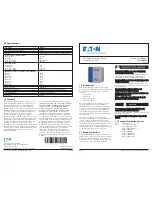
Maintenance
SPDs require minimal maintenance. Periodic inspection of diagnostic
LED indicators ensures proper operation. Clean SPD as appropriate.
Troubleshooting & Service
Please contact TPS Technical Support at 1.888.333.3545 for service
related issues.
Quality SPDs are designed and tested to withstand severe duty.
However, there are various electrical anomalies against which
SPDs cannot protect. These are generally Sustained Overvoltages
also known as Temporary Overvoltages (TOVs). In this context,
Sustained Overvoltages may be only a few cycles. Failed SPDs tend
to be symptoms, not root causes. There may be larger issues at play.
Regardless of cause, SPDs attempt to protect their load until failure.
Bonding or reference to ground problems are the root cause of
many SPD problems. If the SPD shows problems on startup, there
is reasonable chance of bonding/grounding/misapplication issue.
Such problems permanently damage the SPD. If not corrected, SPD
problems will reoccur.
Tip: Visually confirm N-G bonding. Be aware that a voltmeter
measuring N-G can be misleading. For example, N-G voltage
could read 0V because neutral and ground are at the same
potential purely by happenstance, not because they are
bonded. Visually confirm bonding.
Tip: Experience indicates that regulation-challenged
generators can cause Sustained Overvoltages, as well
as ungrounded generators, and/or usual load transfer
systems.
Abnormal N-G Voltage Indicators
This SPD include N-G voltage indicators. If the SPD detects excessive
N-G voltage, the Red Service LED will blink and the Audible Alarm
will cycle. This condition requires immediate attention as the SPD
will fail.
Incorrectly bonded distribution systems damage SPDs. If the XO or N-G
bonding jumper is not installed, the electrical system has no reference
to ground. It becomes an ungrounded system. Please see previous
section regarding SPDs on ungrounded systems. Such systems are
known to eventually produce abnormally high L-G voltages. SPDs
will attempt to chase this system-level overvoltage abnormality until
the SPD fails. This effect is accelerated on Wye systems where SPDs
are designed for grounded systems. (SPDs for ungrounded systems
generally have higher MCOV to allow for L-G voltage fluctuations.)
Failures of this nature are not defects in the SPDs workmanship or
material. This is an installation error and is not covered by warranty.
A differential voltage circuit monitors neutral to ground voltage.
When N-G voltage becomes excessive, an amplifier energizes a
resistor. Eventually, that resistor will overheat and cause thermally
sensitive shrink wrap to shrink around the resistor. This does not occur
on transient or instantaneous N-G overvoltages. When the SPD is
deenergized, the shrink wrap covered resistor can be accessed by
qualified personnel under the display plate cover.
Module Replacement & Service
The module is field replaceable. Service should only be performed
by qualified persons. Deenergize SPD, confirm with appropriate
measurement equipment and discharge internal capacitance to
ground. Mark locations and carefully disconnect diagnostic cables,
contacts, connecting conductors, etc. Unbolt module from backplane.
Reinstall in reverse.
There are no user serviceable parts inside the module. Disassembly
is not permitted.
Modules may be returned to the factory for factory service,
qualification and return. Please contact factory at 1.888.333.3545
for assistance.
CONDUCTING DIELECTRIC AND/OR
HI-POTENTIAL TESTING WILL CAUSE
INTERNAL DAMAGE TO TPS3 UNIT.
Do not perform dielectric or high potential
tests with the TPS3 unit installed.
CAUTION
V
Hazardous voltage.
Will cause death or serious injury.
Keep Out.
Qualified personnel only.
Disconnect and lock off all power before
working on this equipment.
V
DANGER
11


































